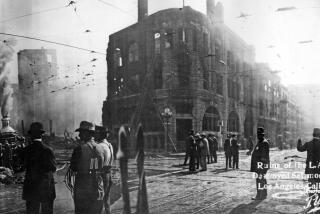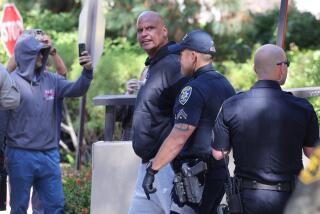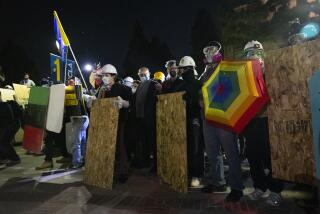NOTEBOOK : The Press Under Fire: Riot Targets Journalists
In the vortex of the worst violence since he became police chief, Daryl F. Gates congratulated rioters for smashing windows at The Times’ building--then said hastily: “joke, joke, joke.”
In the vortex of the worst violence since they were born, some rioters and looters went looking for anyone with a camera, anyone wearing distinctive police-issued neon-colored press passes. “Mother------, stop taking pictures!” screamed one man at a black Times photographer.
In one hand, the man held a stolen bottle of whiskey; in the other, a Beretta. He fired six times at the fleeing photographer--and was so plastered that he missed.
Journalists’ jobs make them nobody’s comrade and nobody’s enemy. That no one loves the press is a given; it goes with the job like a notebook and a pen. On Wednesday and Thursday, “nobody” had guns and knives. They had rocks the size of cantaloupes. In places where the police and firefighters were not in evidence, the press was; white or black, they took the crest of the rage and disappointment.
Times photographer Kirk McKoy already had seen one colleague hit with stones. A few hours later, as Times photographer Mike Meadows stood across the street, his car engine running and the doors open in case of trouble, McKoy was taking pictures outside another looted liquor store.
He had only taken a couple when a bearded man in a T-shirt, with a half-empty whiskey bottle in his hand, ordered him to stop taking pictures. “I was the only guy there with a camera so I assume he meant me,” McKoy said.
Then the man began shooting, half a dozen times or more. “Everybody scattered,” and McKoy ran down the street, dodging and weaving among light poles and debris, crossing to where Meadows pulled them away in a screech of tires.
“I’m glad he was drunk,” said McKoy. “Ten feet away--that’s the only reason I think he missed.”
Not an hour later, as McKoy and Meadows were stopped at an intersection, a man crossing the street demanded, “What are you doing here?” and pulled what Meadows vividly remembers was a pearl-handled revolver. Both ducked beneath the dashboard and Meadows hit the accelerator with his hand, barreling the car through the intersection.
Times staffer Tina Griego and two female colleagues had driven Griego’s little black Honda past the Compton mini-mall several times, and it was like a party, jammed with people emptying the market, the liquor store, “people parked there drinking, laughing.”
Not long before, at another mini-mall, “people were actually mugging for the camera. Someone had pulled back the security gate of a liquor store, and while one man crawled under it, another man came up and said, ‘Take a photo of me. I’m the one who did that.’ ” But this time, when Griego pulled in, a couple of men yelled to the three women, none of them black, “you guys better get out of here--this isn’t a safe place to be.”
Griego looked straight ahead. A man walking toward them lifted his T-shirt and pulled out a gun. “He was looking right at me.” The two women in the car pulled at the photographer’s skirt and she tumbled back into the car.
“I just stopped looking, put the car in reverse, peeled out, then heard a big crash. I thought, ‘The guy has shot at the car.’ ” The man had put his gun back in his waistband and hurled a shopping cart at the passenger side of the car.
“After that, I was just completely conscious of my color,” said Griego, a Latina. “Before, I wasn’t. . . . I got really paranoid.”
Free-lance photographer Scott Robinson was at the Associated Press processing his photos of the day’s events when AP photographer Craig Fujii wandered in.
Wandered was the right word.
He couldn’t remember where he had been or what he had done or even how he had gotten back to the office. There was a swelling lump on his temple.
Staffers pieced together that he had been struck in the head while taking pictures in South Los Angeles, had wandered in a daze and found his way back to the office.
Robinson took him to a nearby hospital, waiting in the emergency room while five gunshot victims were wheeled in. Presently, the emergency desk told Robinson it could be four, five, six hours before Fujii was treated.
Robinson left to take Fujii to Cedars-Sinai Medical Center. On the way out, two emergency medical technicians swabbing blood out of their ambulance told them to go back into the hospital, the streets weren’t safe.
At Cedars, Fujii was being treated when “we heard this screaming, yelling, ‘Get out of the way! Stat! Stat!’ “--and, his uniform bloodied, in rolled a firefighter who had been shot.
Sacramento Bee reporter Andy Furillo, a veteran of the old Los Angeles Herald Examiner, was driving with a black reporter on Arlington Avenue when a car full of young black men struck their car a glancing blow.
Furillo waved his hands--no problem. But all six men got out and one pointed a gun at Furillo. He ducked beneath the dash and, blindly, backed up and steered a frantic U-turn.
The man started shooting as Furillo pulled away. One tire was flattened, but Furillo kept driving.
Race mattered . . . and then it didn’t. White photographer Al Seib and reporter Ashley Dunn, who is Chinese-American, were threatened at Western and Adams with a full bottle of VO whiskey, wielded by a man who sat atop a jingling, shifting load of looted liquor. “Don’t point that camera this way,” he warned, lifting the bottle.
Earlier, at Hoover and Adams, the pair had been given a friendly warning: “You better get out of here; they’re going to kill you.”
Yet a black photographer who works for the black-owned Los Angeles Sentinel had his truck and his camera gear stolen, even after he told them “I work for the Sentinel; I’m on your side,” Times photographers said.
Times reporter Greg Braxton, who is black, was driving west on Venice Boulevard and talking to his office by phone when a young Latino stepped out into the street and raised a rifle. Braxton made a quick U-turn and swerved the car as he drove off, hearing four pops. “He saw me talking on the phone and may have thought I was a police officer,” Braxton said. “That’s the only thing I can think of.”
Times reporter John Mitchell, who rescued a Vietnamese refugee from a hostile street corner Wednesday and saw an Asian man knocked to the ground on Thursday, got no reaction as he stood quietly with pad and pen taking notes in front of a looted store, “but when a film crew pulled up, somebody threw a bottle at the truck. I do think there’s a lot of anger at the media, (but) I don’t think it’s print. I think it’s the hype television gives, the running commentary by the TV folks who don’t know the areas and try to give this instant analysis.”
George Ramos, who served in Vietnam, had been fired at before.
“I thought the war was over,” he said.
Yet Wednesday night, right outside his own L.A. Times office, as people began smashing windows and lugging out computers, a black youth in Raiders garb wheeled on Ramos, pointed a .22-caliber firearm at him from about eight feet away.
Ramos held up his “dog tags”--the bright press passes strung around his neck--and said: “I’m a reporter, I’m taking notes, I’m doing my job. I don’t know what you’re going to do, but I’m doing my job.”
The man froze “for what seemed like an awfully long time,” then turned around and ran down Spring Street, where he picked up chunks of concrete from some street maintenance work and hurled them at windows.
About half an hour later, Ramos walked back into the office. “I suddenly realized I was perspiring like a pig.”
Times staff writer Janet Rae-Dupree contributed to this story.
More to Read
Sign up for Essential California
The most important California stories and recommendations in your inbox every morning.
You may occasionally receive promotional content from the Los Angeles Times.











